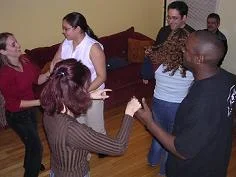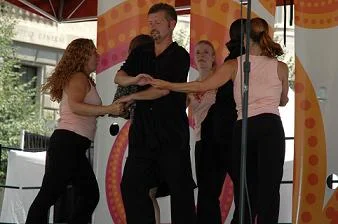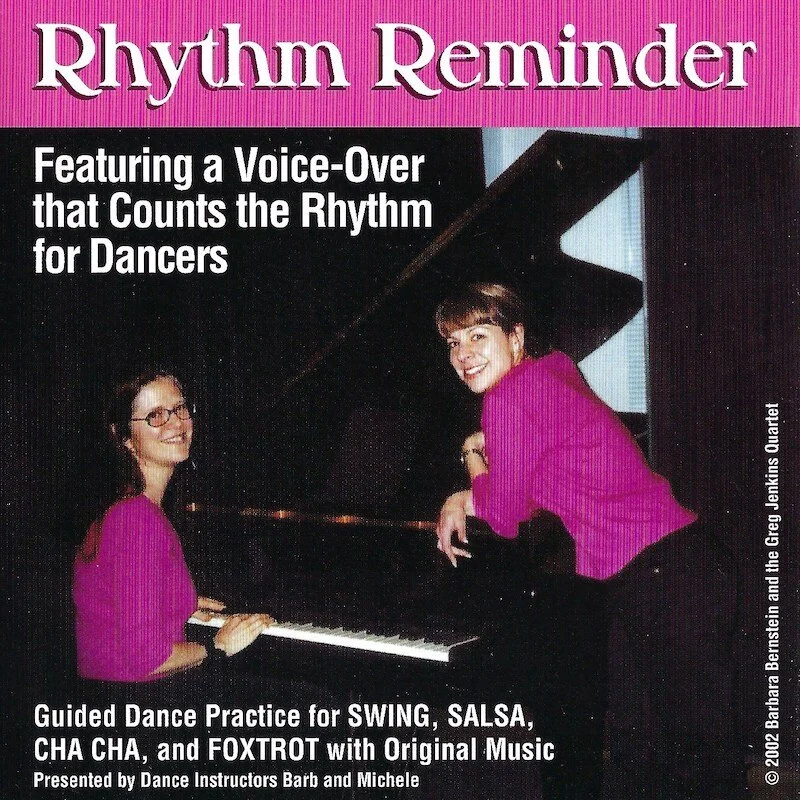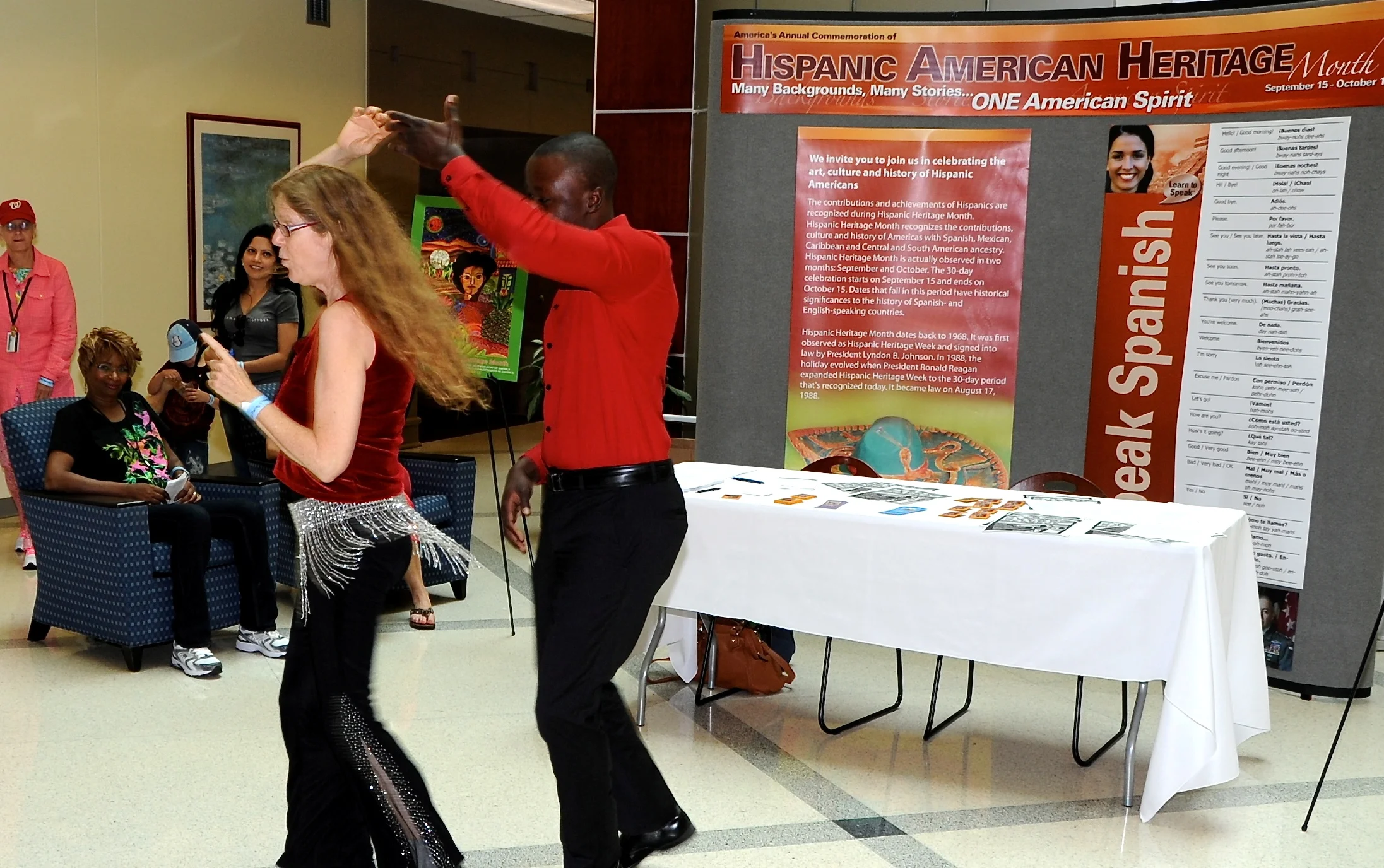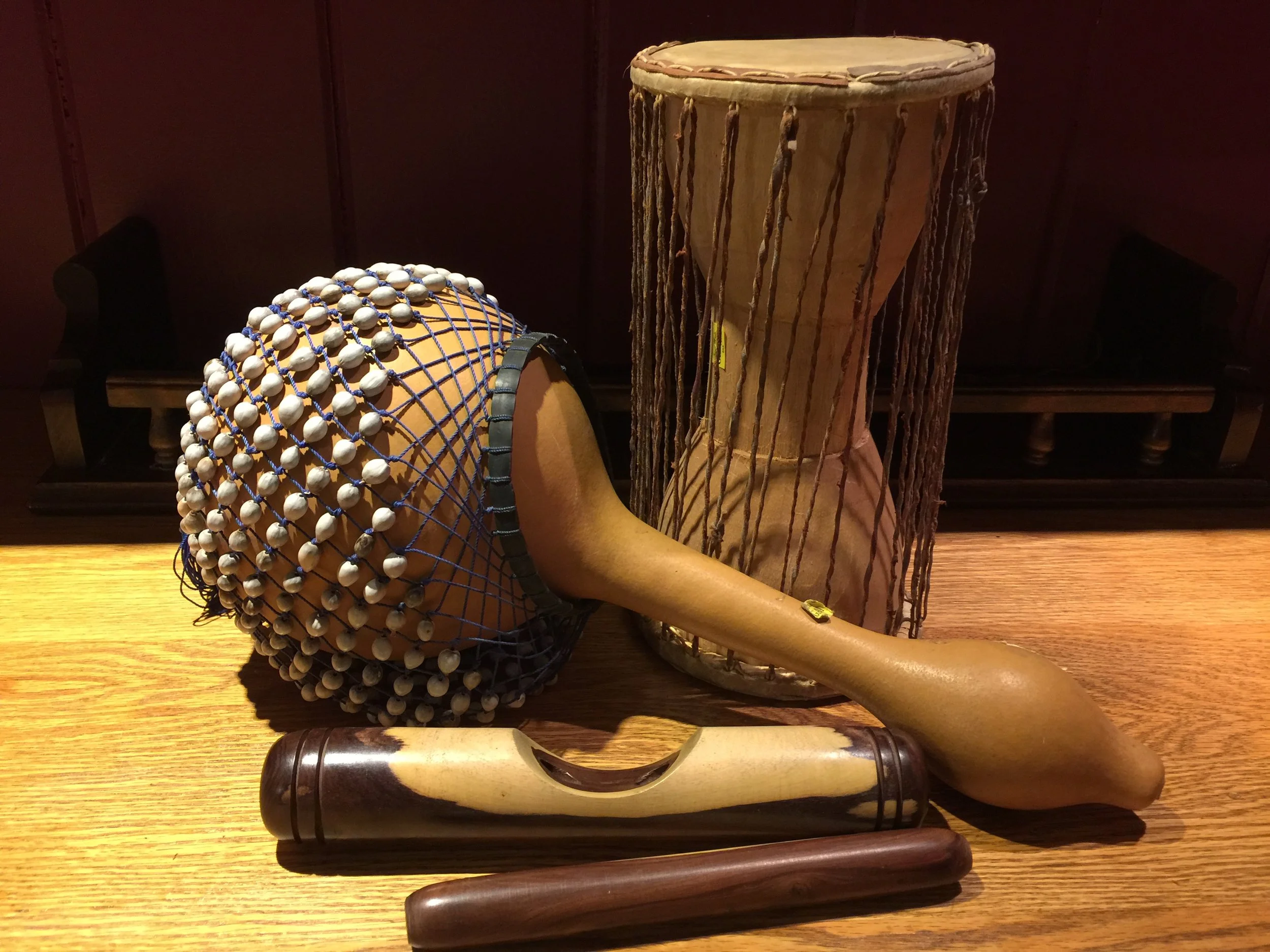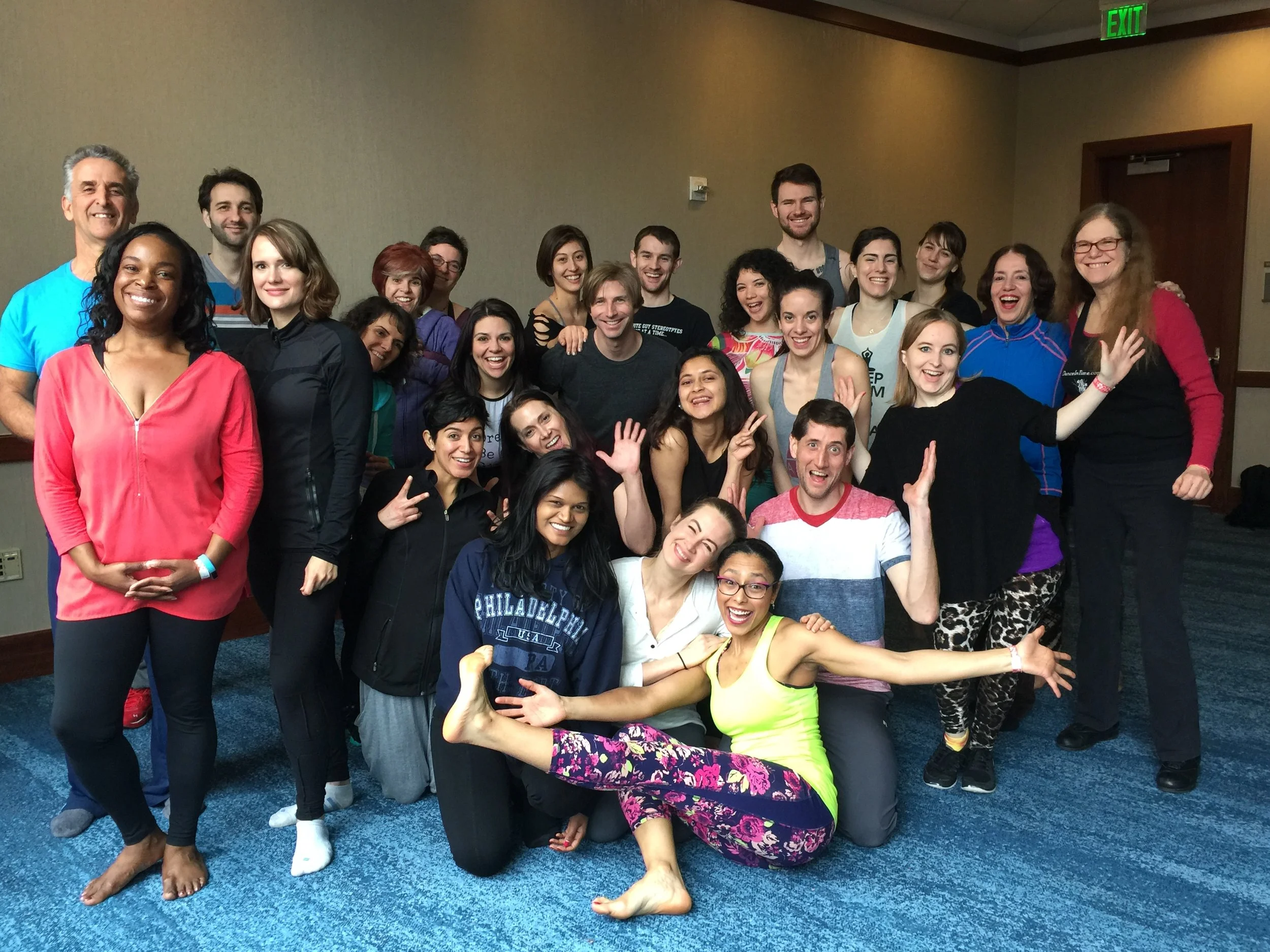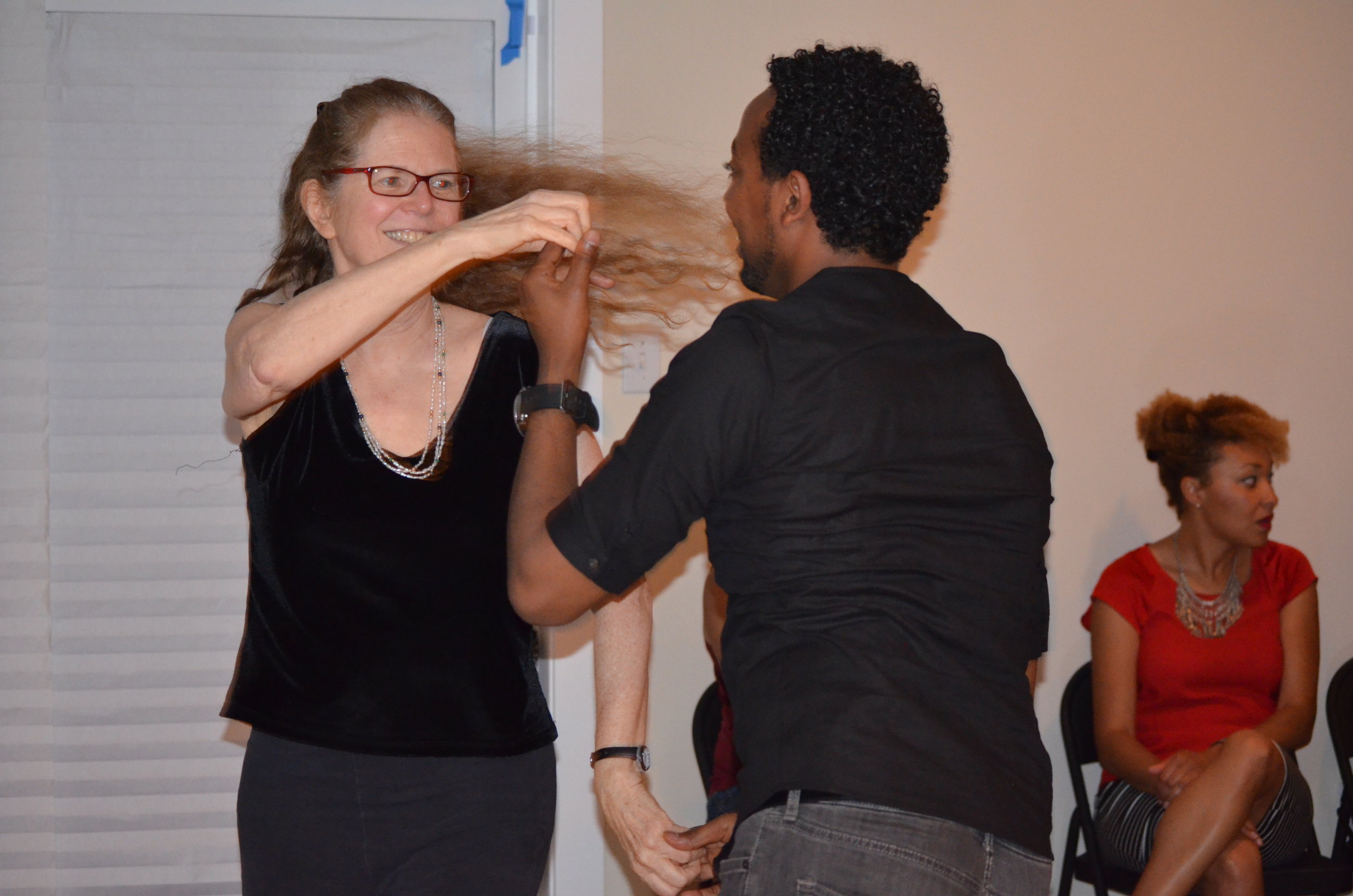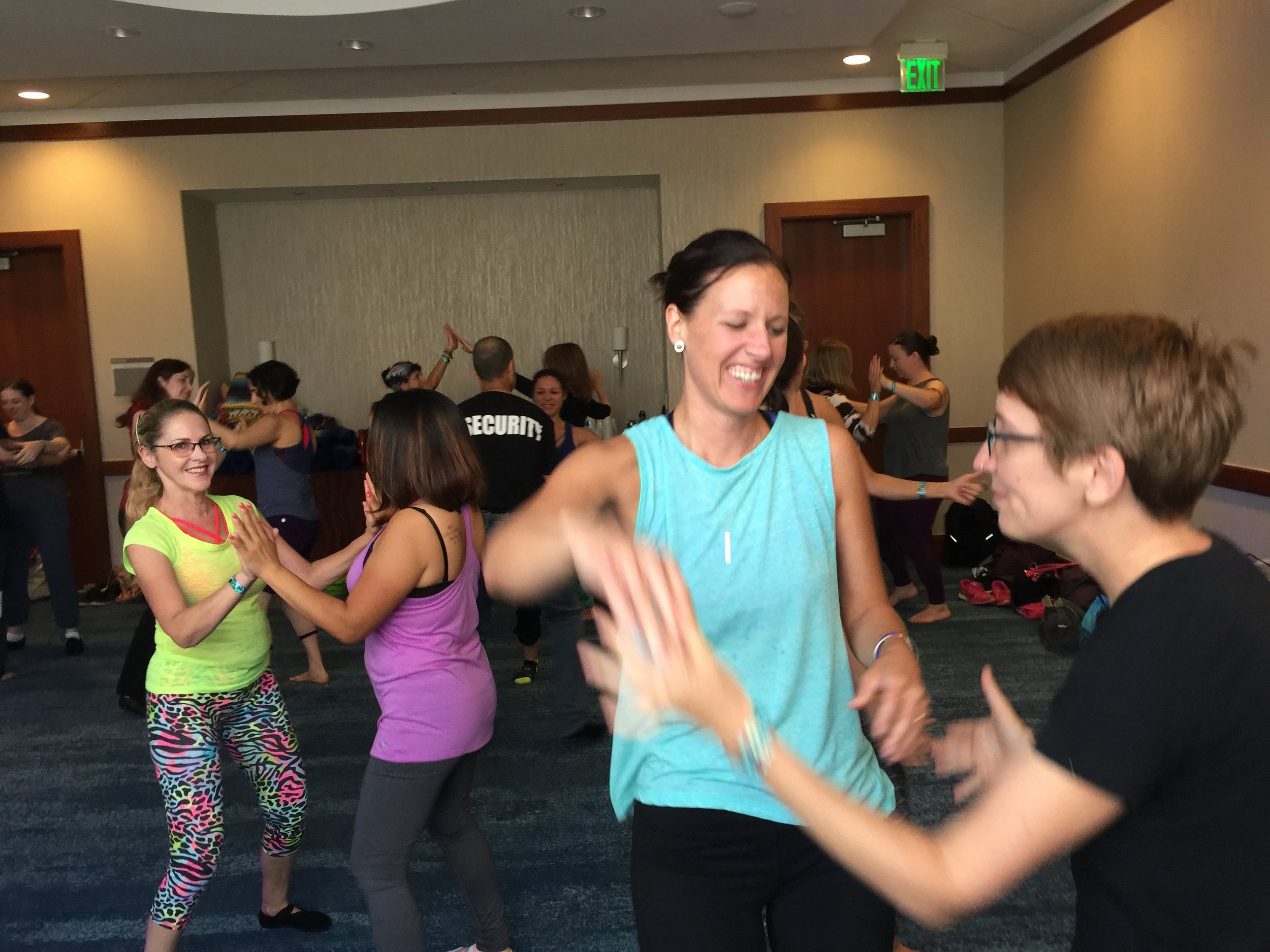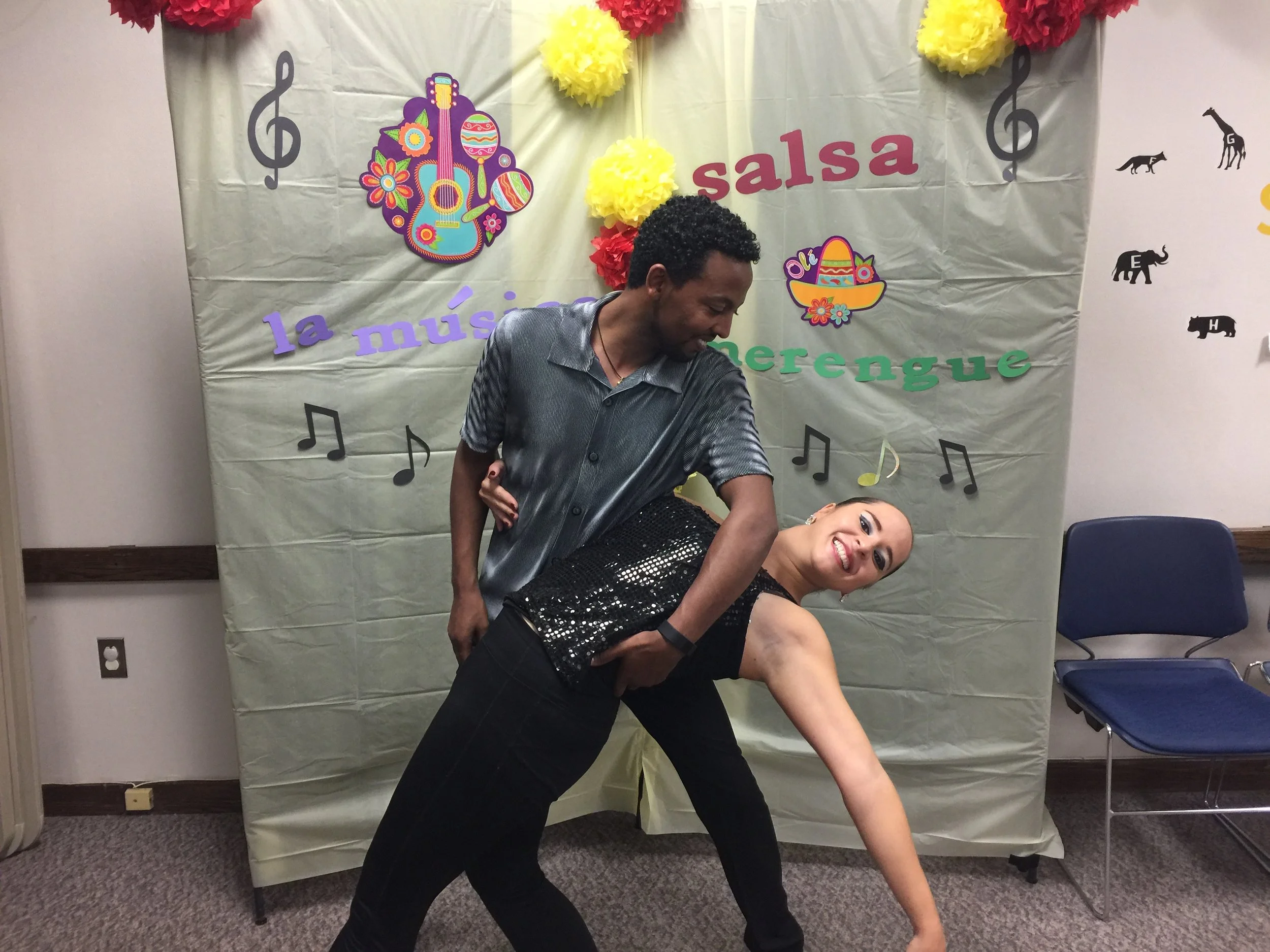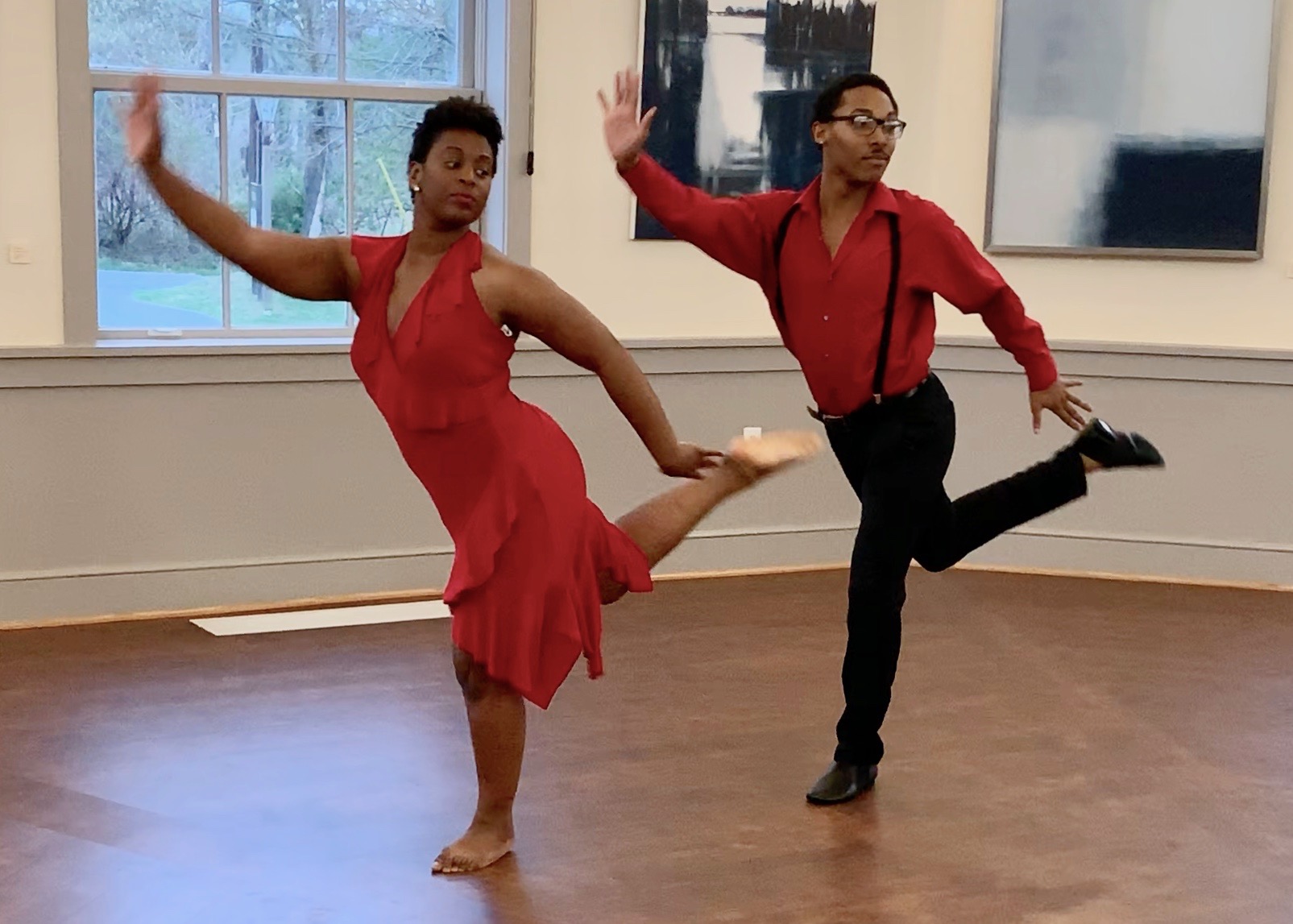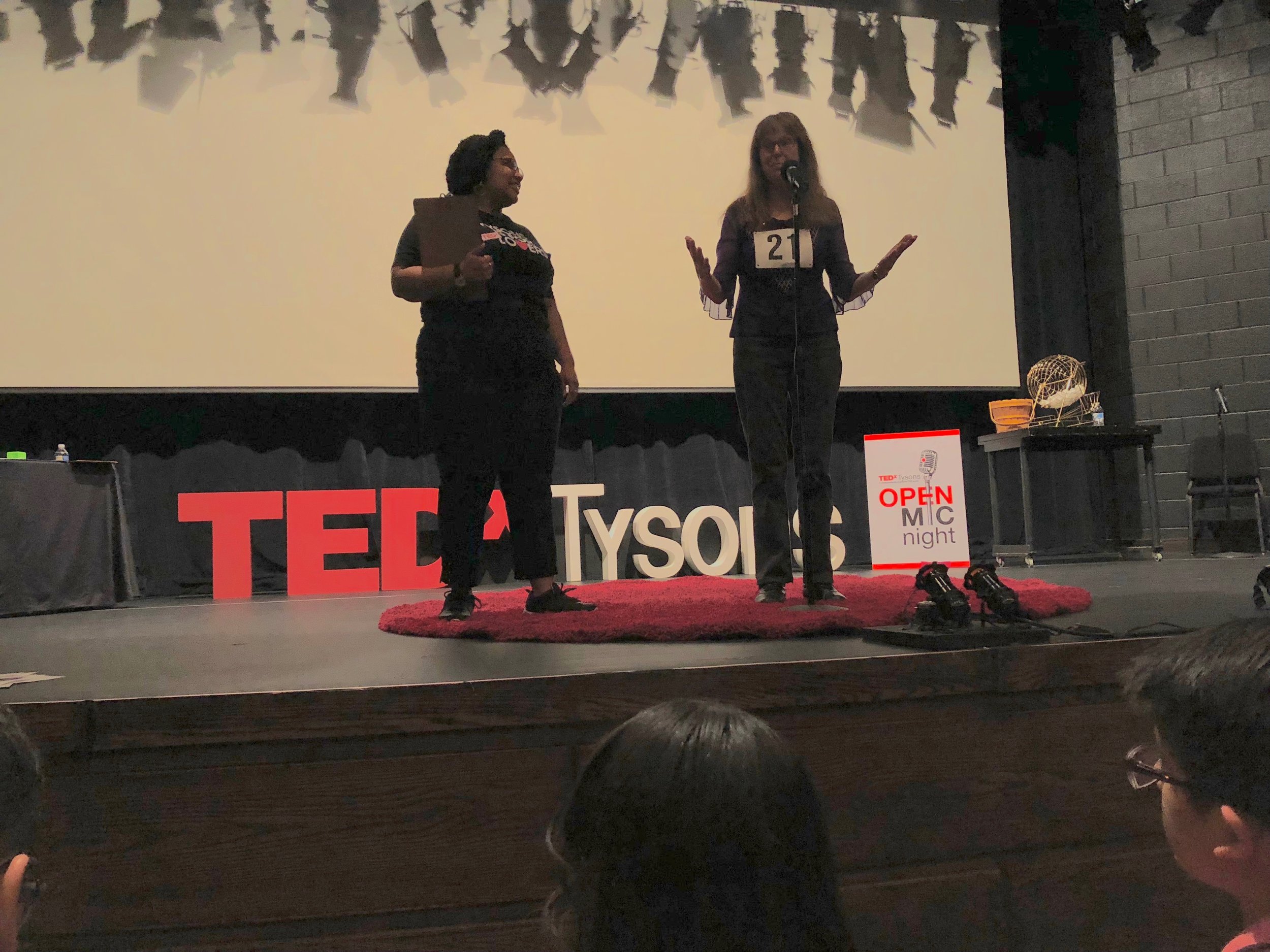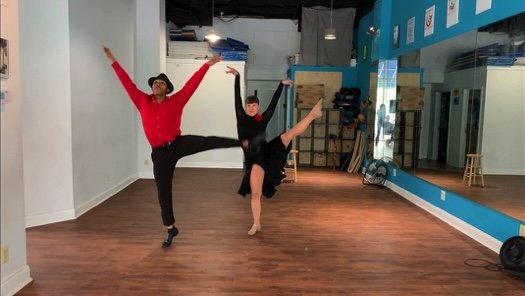Helpful Hints For Learning To Dance
First: Some simple words of advice from Barb Bernstein:
I want to begin with important advice for anyone who wants to learn to dance.....
"It's all about heart. "
There is a line that I love in a dance movie where a teacher is starting a lesson. She says to her students, "Dancing begins with the dancers' feelings." This is very true.
If you want to learn to dance, the most important thing is to derive pleasure from what you are doing. There will be mistakes---many of them, of all types. But if you love to dance, it will be great fun to practice and keep improving. That is really how people become capable dancers.
Regardless of how basic you are when you start out, or how slowly you may advance, anyone can become a good dancer. I have had students over the years who started out having trouble switching weight and keeping time--the most fundamental elements of dance movement. But those who stuck with it over time became very good dancers. Salsa can be done with fancy acrobatics, but usually people simply learn to lead and follow in partnership. The physical actions involved in this are not too different from walking--there are no backbends, no lifts in the air, etc. Social dancers do not have to be in exceptional physical condition; it's a skill that is accessible to anyone who can walk. It just takes patience and heart.
And here is a little hint.... When you look around at a club or in a class, and see people who appear to learn really fast, you can be sure that they have had a lot of exposure beforehand to either dancing, or moving in a rhythm, or listening to music, etc. That is, they have experience or practice at some underlying dance skills. No one comes out of the womb able to step in the quick quick slow rhythm. But life experiences can make this easier to pick up, while having little or no experience makes that a slower process. But it is learnable--by all who can walk!!
So don't be discouraged if you feel you are learning slowly. Remember that you may be watching people who came into a class with some skills that were already built. You can certainly get there too, even if you feel awkward and "dance challenged," by taking the time you need to practice and build those skills. That is why I say that it's all about heart. If you enjoy dancing a lot, you can learn by putting in the time. The expression "labor of love" comes to mind.
In section 1 below are comments on techniques to help dancers learn Cuban Salsa and Rueda. Then in section 2, there are some more philosophical comments on underlying concepts of timing, leading and following, dealing with errors, and how to navigate some of the confusing aspects of taken dance classes.
Note that the material in this discussion is expanded considerably in a number of chapters in the Salsa Dancing and Rueda de Casino Guidebook. For information on this book, visit: salsacasinorueda.com. A short article titled “Different Mindset on Teaching & Learning: lessons from Dance Instruction” presents an excerpt from the book. It was published in a journal produced by the American University Center for Teaching, Research, and Learning (Fall 2024 issue). Read that here: https://edspace.american.edu/thectrlbeat/2024/07/24/a-different-mindset-on-teaching-learning-lessons-from-dance-instruction-barbara-bernstein/
Enjoy!
Barbara Bernstein, Director of DanceInTime
********************
1. Specific Techniques For Learning
Starting young
Many of us have heard that some skills are best learned when someone gets “an early start.” Although that is not at all necessary for learning to dance partnership Latin dances, it can indeed be helpful. If you have children and want to encourage an interest in dancing, or help them develop some skills early in their life, there is a clear path to this goal that is very successful. And it’s easy, too. Just let them see you dancing with joy. Let them hear music and that you enjoy listening to. Let them feel the vibe of deep satisfaction that you get from dancing to beautiful music. That sets them on a course for seeing these activities as joyful and makes it much more likely that they’ll pick them up as hobbies (or more?!) in adulthood. Whatever they learn as young children isn’t so important. The important thing is to foster interest and enjoyment in dancing and doing music activities. That can stay with a person for life and—there is lots of time to pursue one or another hobby throughout the course of a life.
DON'T BOUNCE YOUR STEPS WHEN YOU DO SALSA DANCING
You should generally not bounce your steps in Salsa or in Rueda de Casino dancing. The knees are bent very slightly throughout the steps, and the head stays at the same level so that steps are smooth. When knees are bent and then straightened even slightly, this creates a bounce where the head goes up and down. Instead, what experienced dancers do is keep their knees bent about the same amount throughout the dance so the head remains level. The steps are like walking steps in this respect.
KEEP YOUR WEIGHT OVER YOUR FEET, NOT THROWN BACK
Keep your weight over your center; don't lean back on your heels. Back weighting slows you down as you have to shift your weight forward before you can take the next step. This in turn, can cause dancers to be slow and off time. When people take a back-rock, they often don’t even put their heel on the floor to avoid back-weighting.
WATCH OTHERS IN A RUEDA AND TRY TO SYNCHRONIZE YOUR MOVES WITH THEIRS
Remember to watch other experienced dancers and match their moves so you are in synchrony with them. Mimicking others is a useful technique in this dance, but not everyone remembers to do it.
KEEP YOUR EYES ON THE CALLER AND LISTEN FOR THE CALLS
Listen to and watch the caller so you don't miss a call. That is the responsibility of every dancer in the circle.
KEEP THE CIRCLE CIRCULAR AND TIGHT!
Pay attention to keeping the circle tight and circular. That is also everyone's responsibility. Try to stay fairly close to the perimeter of the circle, especially on moves where it's easy to pull away.
STAY CLOSE TO YOUR PARTNER
Both partners generally should keep enough tension in their arms so the elbows stay bent. If partners extend their arms fully, they get too far from each other and leading is compromised.
KEEP YOUR FEET MOVING IN THE QUICK QUICK SLOW RHYTHM, EVEN IF YOU'RE "STAYING IN PLACE"
Let me tell you what it feels like to be a leader and come to pick up a new partner who is standing still. It feels like the follower has stopped dancing and it's unsatisfying. Followers should keep their feet moving in the quick quick slow rhythm, even if they aren't "going anywhere," so they look and feel like they're actually dancing!
This applies to all steps where either leaders or followers stay in place. The group spirit of a Rueda circle is augmented by having everyone move in the same rhythm. So even if you don't have to take a step to move or turn, keep the feet going in rhythm. This also helps ensure you'll know which foot to step on when you do need to move!
HOW MUCH LEAD IS TOO MUCH LEAD? THE ETERNAL QUESTION
There is a lot of variance in how forcefully people lead. Likewise there is a lot of variance in how much lead followers prefer. There is no one correct answer to the question of how much lead is too much. Personally, I prefer as much lead as necessary for clarity and no more (a sort of "economy of lead" principle). If you start the follower in motion and momentum will continue moving the follower along, there is no need to continue pushing. That doesn't mean you don't provide contact. But force isn't needed to get someone to go where they are going to go anyway!
Or if you are doing a turn or alarde, there is no need to raise the follower's arm very high over her head. You just need to clear the head. To raise the arm high, the lead has to be more forceful. So you can keep the lead gentle by moving the arm only as high as needed. It takes a greater level of sophistication as a dancer to lead effectively but still be gentle. It's much easier to lead with force.
There is one more notable point regarding the strength of the lead. If someone has too little lead, they'll find out. The follower won't know what to do, so it's obvious a firmer hand is needed. But if your lead is extremely strong, you don't get feedback on that as readily. Everyone you dance with will follow just fine; but it may not be comfortable. So if you value a gentle lead, this is something to bear in mind.
FRAME AND TENSION TO MAKE LEADING AND FOLLOWING POSSIBLE
Following a lead properly requires some basic understanding of frame and tension. This is something people develop over time and experience. When followers who aren't experienced dancers first try a turn, they often let their arm move back but don't move their bodies, as their partner tries to lead them.
To follow a lead, the follower's arm maintains a shape so that the follower can be pushed/guided (gently!). Because followers hold the shape or frame of their arm, the leads can move them by moving their hand at the point of contact. I have seen a number of interesting ways to explain the concept of frame. One is that ladies must be able to see their right arm out of the corner of their eye. So the arm never goes outside their range of vision. Thus, when the arm is pushed in an effort to turn the lady, her body has to go with the arm---and (voila!) she has been led!
Another unique way to explain this was shared with me by a friend, Melinda Turner. She said she was in a class where the teacher passed out tennis balls to the followers. They were all told to put the ball under their right armpit and dance without letting it fall. Then when the follower was turned to the right, she had to hold a rigid frame and move both her arm and body, or the ball would fall.
I've never quite had the nerve to bring tennis balls to class, but this is an outstanding way to convey the concept of frame. I have found that even just describing this in words from the beginning, and asking the followers to imagine a ball is under their arm, is enough to get the concept across.
2. The Big Picture and the Philosophy of Learning
PRACTICE MOVES YOU ALREADY “KNOW”: IMPROVING TECHNIQUE VERSUS LEARNING NEW MOVES
Practicing dance moves you "already know" is far more useful than it may seem. The more you dance, the more your technique improves, and these gains cut across all the steps that you do, so they are far-reaching.
Musicians (and singers) often warm up by practicing scales, for example. This is very useful but it is not done because they don’t know the scale or forgot how to play it. Rather, it is useful because the player’s fingers become increasingly nimble, the movements increasingly natural and easy, etc.
Likewise, as you practice dancing, you get to know the steps you are doing better and better. So you naturally execute them more competently---at faster tempos, with less thought, easily adding embellishments, etc. Practice clearly improves your dancing, even when you are practicing steps you had already learned. Moreover, the more automatically you can do the fundamentals, the easier it is to use those components in more advanced moves. (See footnote 1.)
In short, the time spent in class, refines and smooths out your execution and makes your lead/follow feel comfortable to your partner. Trust me----if you join a Rueda circle during club dancing, you'll see the tremendous value in this. The music at a club is much faster than what is generally used in a class, and the calls are very hard to hear and recognize. Plus different callers say the names of the moves slightly differently. To dance Rueda successfully in a club, you have to know the moves "like the back of your hand."
TIPS ON RHYTHM AND TIMING
When someone has trouble with Salsa or Rueda de Casino timing, the most common error is that the "slow" step is shortened. As a result, the three steps in the musical measure are equal or more equal in time than they should be. (See footnote 2.) The "slow" step should be twice as long as each "quick" step.
Timing issues are a very hard thing for people to correct on their own. If they could feel the correct rhythm, they'd be doing it. Progress can be made, but it is long and slow. Generally, when I teach in a Rueda circle, if I say "quick quick slow" or "step step step" in the correct rhythm, people can match their steps to my words relatively well. So that tends to help dancers stay on time and keep the Rueda circle flowing in class.
But how can someone practice and improve this when they are not in a Rueda circle with a teacher hammering out the beat? I've found that it can help to practice a particular move very slowly, to get the feel of the “slow" step taking twice as long as the “quick" step.
Many people can keep the rhythm ok in the basic step but lose it as soon as they are turning or doing something more complicated. For example, dancers may lose the quick quick slow timing when they do a turn like vacila. But if they walk the movement through very slowly in the correct rhythm, that helps give them insight into how this rhythm should feel.
Since many people who have trouble with timing are aided by having a teacher on hand to count out loud for them, I made a CD on which I voiced over the quicks and slows for students. Using the CD, dancers can be sure they are practicing correctly! There is ordering information on this website for my CD.
If you have had a teacher tell you that your timing is off, it's a good idea in a Rueda circle to pay special attention to what others are doing. Many students don't take advantage of the benefit they can get by watching others and trying to match them. You move when they do. For example, if a follower is coming across for the cross body lead too early, that can be corrected by trying to mimic the timing of others in the circle. Likewise if leaders are moving to their next partner too early or late, they can watch the other leaders and synchronize with them.
Leader in one on one Salsa dancing who are aware of having a timing problem can pay special attention to their partner's timing. I have watched couples dancing where one person is off time and the other is attempting to step correctly. If the person who is off time were aware of the issue and tried to be responsive to his/her partner's timing, that would no doubt help.
To complicate things further, be aware that Salsa and Latin music change tempo a lot, so dancers really have to be listening to the music constantly!
COUNTING SYSTEMS---THE PROS AND CONS OF VARIOUS METHODS
The most common way for dancers to count Salsa when they practice, teach, learn, etc. is by the beats. Most dance music is in 4:4 time. That means there are 4 beats to what is called a "musical measure." The first beat of each measure gets a slightly stronger accent.
When we dance to Salsa music, we take two quick steps each lasting one beat and one slow step that lasts two beats. The phrasing in Salsa music is that every other measure receives a particularly strong accent on beat one. So we think of Salsa music as being constructed in sets of 8 beat phrases where the first of those 8 is the very strongest accent and beat 5 is the next strongest.
When experienced (“on1”) dancers count Salsa or Rueda moves, they most commonly count 1, 2, 3, 5, 6, 7. These are the beats on which people take steps. However, some teachers count by naming the number of steps taken, so they count 1, 2, 3, 4, 5, 6 instead.
If I am teaching people who fail to lift their foot and shift their weight each time they take a step, then I count by saying "Step, step, step; step step step." In a sense, this is literally a verbal reminder that every dance step is "truly a walking step.” We lift a foot off the ground and put it down to take a step when we walk. I have found that this wording helps students remember to lift their foot off the ground!
If I’m teaching students who are not waiting two beats for the slow step, I may count: "quick quick, wait!” to help them remember to wait a full two beats.
Implicit message: Language matters in teaching!
WHAT IF ONE TEACHER TELLS YOU ONE THING AND ANOTHER TELLS YOU THE OPPOSITE?
What do you do when advice from two teachers, or from any two people, is contradictory? I would submit that if one teacher tells you to have tighter arms and another tells you the opposite, that doesn't mean one of them is wrong. Lots of things are correct in one place and not in another (i.e. different steps or different parts of the same step). Also, the “proper” level of tension is a matter of degree, and different teachers may draw the line a bit differently. In addition, your arms may be “right" for dancing with one person but not for dancing with another (due to the level of tension your partner has); etc.
Different teachers emphasize different things, conceptualize things differently, explain them differently, and have different taste, strengths, and weaknesses. All these things affect how and what they teach. So they'll sometimes say opposite things, but that doesn’t mean one of them is necessarily wrong. They may both be right if you fully understand the point each of them is trying to make.
Oftentimes, I hear students comment in frustration that they are told opposite things by different teachers or by the same teacher (said at different times) and they don't know which piece of advice to follow. This is a difficult matter, and it happens to many people as they learn. You have to evaluate and analyze what is meant, and how you can best understand the intent of the advice.
Teachers are generally trying to help students learn to dance as smoothly and comfortably as the student is able. That may lead the teacher to say something to exaggerate a point, for example, if the teacher feels that is the only way to be heard. You can see how this might lead someone thinking that a comment made to them must be wrong.
My point here is that contradictions are not always an indication of an error. As you progress in dancing (or in your understanding of anything), you get more of a handle on the sense in which two opposite pieces of advice can fit together and both be valid and valuable. That kind of sophisticated understanding requires a broad perspective and comes from experience. So keep an open mind as you try to grasp the meaning of the advice that a teacher gives you! (Remember, you can both love and hate someone, too! So things that appear opposite aren’t always mutually exclusive!)
MISTAKES — LEARN TO LOVE THEM!
My philosophy on mistakes is that they are the best learning tool anyone has. When I taught mathematics, many moons ago, I preferred that my students write in ink and not erase their mistakes. It is very instructive to look at your errors to be sure you are clear on why you thought that way and why it's incorrect. I'd much rather have students guess wrong if they aren't sure so we can address the matter, than guess right and squeak by, still confused.
When I teach dance, if I make an error, I often stop and ask the class if they can figure out what I did wrong that messed them up. For example, calling is a frequent source of error. No one can mess up a Rueda circle like the caller can. One bad call---too early, too late, too soft, a mixed up step name----and the whole circle is shot.
So when I make mistakes, I like to use them as learning tools, just as I do with students' mistakes. When the students can assess what I did wrong, they are on their way to understanding the dance better. I don't sweat my mistakes and I'd like students to feel the same way.
If you can think of your own errors as opportunities to learn and go forward, you'll be more comfortable making them. And you can't learn much unless you are willing to make mistakes, particularly not in dance!!
WHO WAS RESPONSIBLE FOR THAT MISTAKE?…. IT’S ALL ABOUT US!!
There is another dimension to errors that I'd like to point out. When two people dance together, as when they do anything together, what they do affects each other in a profound and ongoing way. For example, if a couple is dancing together and the follower doesn't have quite enough tension in her arms, the leader must lead more forcefully so the steps can be followed. To avoid feeling yanked, the follower may loosen up further. The leader must then lead even stronger. As 6-year old kids on a playground might say, "You started it!" But the reality is clear — they are both creating this situation.
The interactive nature of dance understandably gives lots of opportunity for partners to subtly affect each other. Naturally, when there is a mistake, it can be hard to parse whose error it was, and really it doesn't matter. It was the partnership that failed. Better to grasp the complex nature of this mini-ecosystem where everything affects everything else, than to regard matters as simple. (See foonote 3.)
Moreover, sometimes when a mistake is made, a good many people all played a small role. Here is an example: I was dancing with a wonderful, considerate friend, and while turning, I lost my balance slightly. As a result, I swung out a bit farther from him than he had reason to expect. He moved toward me to "stabilize the partnership" but before that maneuver was complete, I lightly bumped into another couple on the floor. The truth is that they were dancing "a bit large" if you know what I mean.
My partner immediately gestured that it was his fault, since it's the guy's responsibility to watch out for the other couples on the floor. The other couple apologized because they knew they were taking up too much space for the crowded floor. And of course, I felt my partner was just being nice; it was largely my fault for swinging out too far. He couldn't have anticipated that I would do that. Truthfully any one of the three parties involved could have avoided that collision.
So whose fault was it? Many things are joint affairs just like this. To learn from mistakes, it is helpful to appreciate the complex nature of how they come to pass rather than regard one person as causing the error.
Here is another way of thinking of this matter. Many times there is a range of what is correct in terms of how a move is done. For example, consider the matter of how partners stay connected. Each partner has a certain level of tension in the hand hold and a shape for holding their hand which enables partners to stay in contact. However, there is a range of tensions that will be satisfactory.
If the leader is in the proper range but at the low end and so is the follower, they may disconnect even though they were both dancing “correctly." There is a temptation for an individual to feel that since he/she did a move correctly, if it failed it must be the other person's fault. But again, it can be the partnership or the union of how those two individuals dance together that really caused the error.
In other words, just because you were "right" doesn't mean the other person was "wrong." Often no one was exactly wrong! Partners need to learn to work together effectively, looking at what happened to figure out how both can contribute to avoiding errors in the future.
CONSIDERATION ON THE DANCE FLOOR
Dancing is a social experience and a contact sport. This has many implications. It is nice to smile (but not stare) at your partner. Also, if a leader’s partner has difficulty doing certain moves, the leader should try to adjust so those steps aren’t led.
Some people worry that they won't look good if they "dance down." But your partners will appreciate your leading things they have some hope of following, or slowing down your pace (how quickly you initiate one move after another). And overall you may look better than if you are forcing a partner through moves that can't be done gracefully.
Besides, everyone who goes to clubs knows very well the level and style of everyone else's dancing. If you dance with someone who is more of a beginner than yourself, what you really look like is someone who is generous and willing to share your talent with others. There is absolutely nothing that endears you to other dancers more than this! Plus, dancing for fun shouldn't be just about how you look, anyway!!
FOOTNOTES
I want to point out something else here. People sometimes regard learning as a relatively "all or nothing" proposition, but that's not really the way it works. By that I mean that we tend to feel that we either know a step or we don't, or maybe are at some mid-point in between. But I believe that there are many more degrees of learning than is commonly appreciated. Even if you can do a move well from memory, if you practice it more and more, it will improve in some ways. I see learning as highly incremental, and I think it's helpful to appreciate the implications of this.
Let me give you a simple example of the incremental nature of learning from my days as a math teacher. If you teach a class to add fractions, you can start with a simple problem like 1/6 plus 3/6. You can "move up" to a problem where they have to get a common denominator like 1/2 plus 1/4. Students can almost visualize these problems, imagining that fraction of a pie and they'd know what the sum is just from experience. A teacher might feel that if the student can correctly solve these problems, then he/she knows how to add fractions.
But if that student cannot also find the sum of 2/9 plus 5/20, then I would submit that he/she doesn't understand how to add fractions that well or that fully. It is the level of complexity of problems that someone can correctly solve that measures how well they understand. Understanding is very incremental, and the harder the problem a student can solve, the better they have to understand the material. All learning is like this, including dance.
I used to sing in a barbershop quartet for women, and the most common error that was made in singing was also for the timing of the notes to be equalized. That is, short notes were lengthened and long notes were shortened to make them all more equal in length. I originally became aware of this because I harmonize by ear and often "resolve a chord" over the course of several beats when I sing with others. But many times, before I can achieve the final resolution, the person I am singing with has begun the next phrase----very frustrating!!
I once took tango lessons from a teacher who spent a lot of time analyzing in great detail this kind of interaction. There was virtually no dance problem we encountered that didn't have a contribution by both partners. I consider the teacher a sort of "psychologist-dancer." His lessons were really fascinating; he taught me some valuable lessons.







